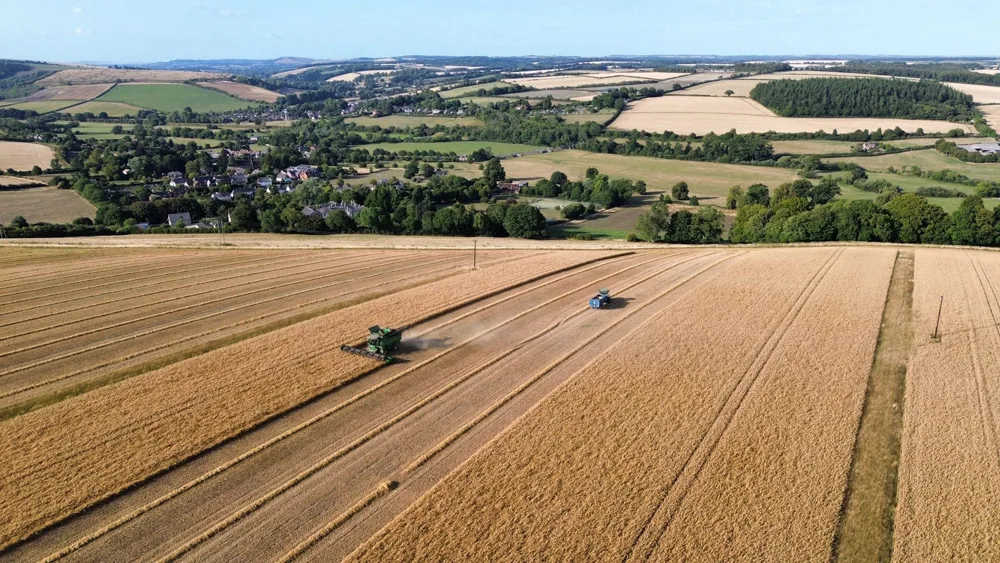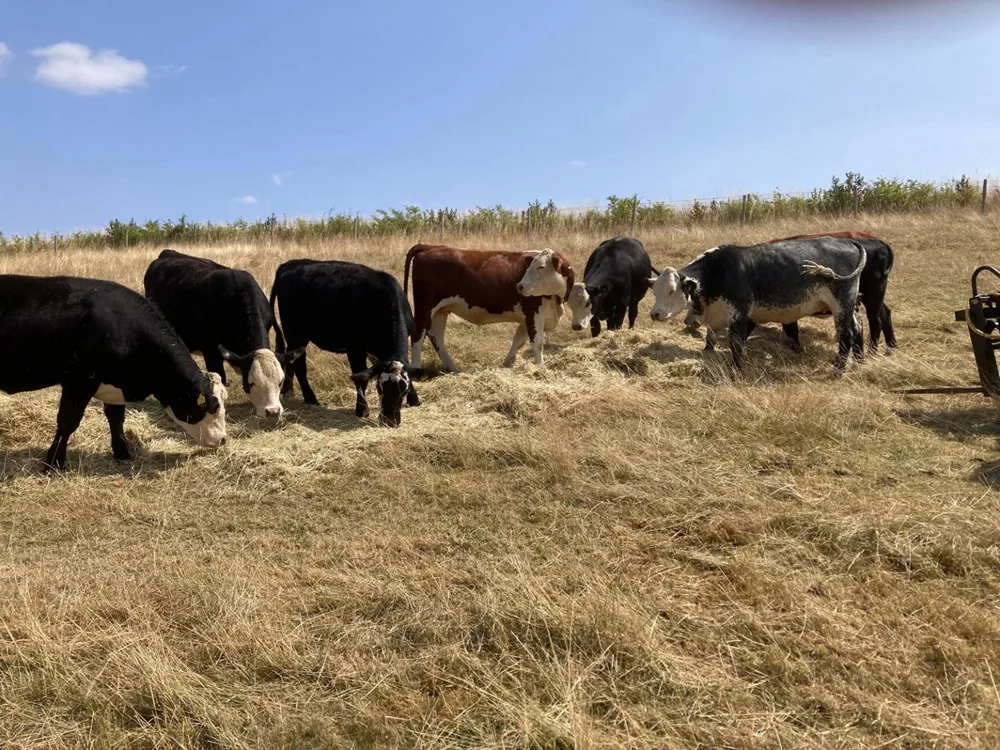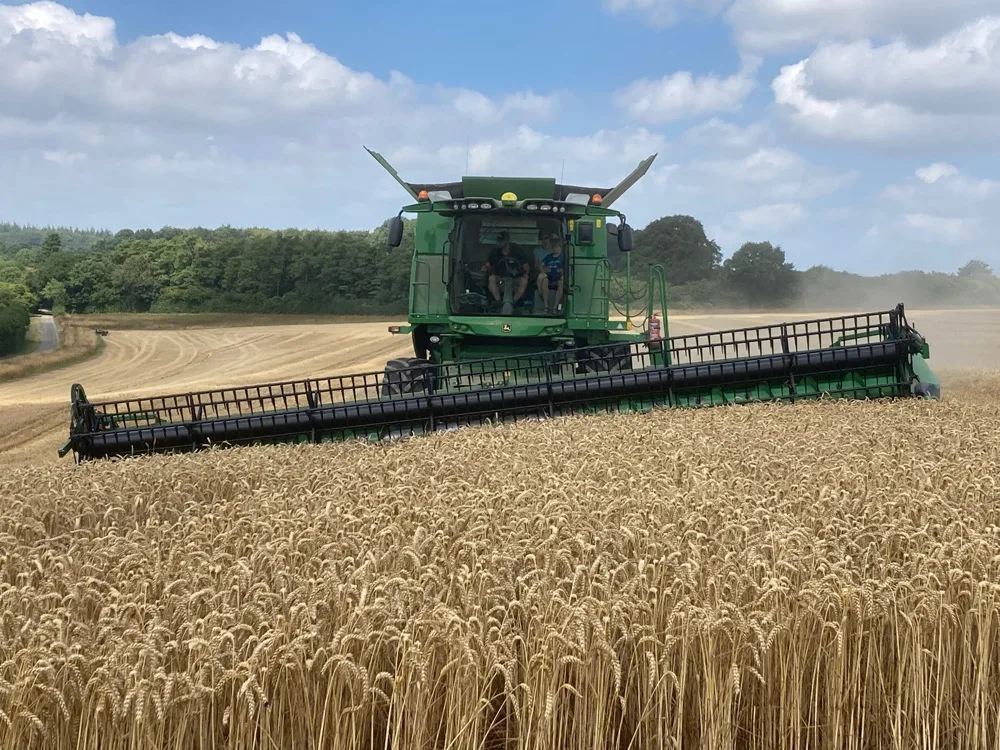Oats have frustrated George Hosford this year … almost as much as politicians and DEFRA and the Countryside Stewardship Scheme

Everyone loves working on the Knoll (the field with the combine harvester above) – the view stretches out over Durweston and Stourpaine, with Hod Hill behind and Hambledon’s yews just sneaking in, top left. It’s hard to keep your eyes on the machine you’re supposed to be minding. It’s a spectacular spot, and it produced a surprisingly handsome spring oat crop this year, stretching thickly from one side to the other. The bi-crop beans sown alongside didn’t fare so well – the drought all but wiped them out, and the few survivors stayed tucked beneath the oat canopy.
The frustrating thing about growing oats is that, despite the quality of the crop, they rarely command the price they deserve. Oats consistently sit below wheat and barley on the price scale, and the UK oat market is notoriously volatile – a classic feast-or-famine setup. It’s a relatively small market, easily over-supplied, and when that happens, prices crash. This year, the problem is worsened by a national carry-over of good-quality oats from last season, which continues to suppress the market.

Let’s not discuss food
A trip to the County Show last month was enjoyable, as always. Tom Bradshaw, NFU National President, was present, and in the NFU tent delivered a pretty sobering assessment of many issues currently facing agriculture, not least the sudden and unexpected replacement of Steve Reed as Secretary of State at DEFRA, with the rather less well-known Emma Reynolds, formerly Economic Secretary to the Treasury, another in a long line of DEFRA secretaries to be inducted into the world of landscape and agriculture.
Tom Bradshaw had developed a strong working relationship with Mr Reed, which he pointed out is of huge value, even when many areas of difference exist between parties.
It is to be hoped that the same can be achieved with the new incumbent.
Her origins lie in the countryside, so let us be optimistic that she might at least be able to approach the new job with some feeling for the rural issues.
There are, of course, some huge issues for her to get to grips with: number one being DEFRA itself. Due to the utter incompetence of the last government, coupled with the utter incompetence of the new one, DEFRA has made a complete hash of the budget controls required to get the new environmental schemes working fairly and properly. Some stories are breathtaking – farmers allegedly receiving four times as much in SFI (Sustainable Farming Initiative) payments as they did under the old BPS (Basic Payment Scheme) system. No wonder DEFRA ran out of money …
They still won’t come clean on how much funding has been allocated to the various SFI iterations, to capital works projects and to landscape recovery schemes (rumoured to be very expensive).
It seems that the ‘wonderful’ new payments of ‘public money for public goods’ really were too good to be true. If it isn’t sorted out PDQ, there are going to be some very unfortunate consequences. Tom told us that more than 5,000 farmers will be coming out of their five-year Countryside Stewardship schemes this autumn – and right now, there’s nothing for them to reapply for.
We ourselves will be in the same boat in two years’ time. What are farmers supposed to do with the long-term options they committed to – plough them up? In our case, we have 75 hectares of flowery field margins, which, together with the hedge and a neighbouring margin, form a 15 metre-wide wildlife corridor between fields. It would be an absolute travesty to cultivate and crop this back to the hedge.
There’s also an area of arable reversion, where we sowed genetically-appropriate seed stock into a small, stony field. It’s now a haven for downland flowers, insects, birds and small mammals – along with grazing animals, which don’t stay long, as it’s not particularly productive in modern agricultural terms. Without environmental payments, we simply cannot afford to farm like this – there’s always rent and a load of other bills to pay. We desperately need the next phase of SFI to be announced, and some consistency and continuity applied to agricultural policy.
Did anyone even mention food …?

A Knoll with a view
With Will at the helm, the combine below is demonstrating its self-levelling ability. This is a John Deere speciality: other manufacturers use different systems in an attempt to replicate this true levelling effect, such as by cleverly shaking the sieves so they throw the grain uphill to utilise the whole cleaning area. An essential component of the combine’s thrashing system is to be able to separate the seed from the chaff, and if you can imagine using a sieve on an angle, the grain will always fall to the lower side, which drastically reduces efficiency.. The whole body staying level allows the grain and trash to spread across the whole thrashing system: this allows even distribution of the flow of cleaning air. Not only this, but it is far more comfortable for the driver than a fixed chassis machine.
It is old technology now: we bought our first self-levelling combine in 1994, and are now on our fourth, each one slightly larger than the previous. We would not be without the self-levelling.
It is not available for those on tracks, because the system relies on the ability of the machine to roll on the tyres as it changes angle: flat tracks can’t do this. Their advantages of lower ground pressure and superior grip on steep land do not, in our estimation, outweigh the ability to not spill your tea.


